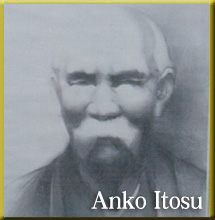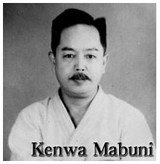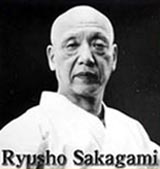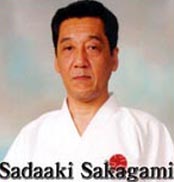1st Soke Itosu-ryu karatedo stems from the lineage of Shuri-te master Sokon Matsumura (1798-1890). It was founded by Anko Itosu (1830-1915), the first Soke who was born in Gibo, Shuri, Okinawa and is popularly regarded as one of the fathers of karatedo. He taught karate as part of the physical education curriculum of P.E. at Shuri Elementary School by refining tode-jutsu into a P.E. form and character development. This was the first step in the popularisation of karate. Anko Itosu also created many kata, including the five Pinan kata (Heian kata in some schools), which are the most widely practiced kata in the world today.
Itosu-ryu karatedo stems from the lineage of Shuri-te master Sokon Matsumura (1798-1890). It was founded by Anko Itosu (1830-1915), the first Soke who was born in Gibo, Shuri, Okinawa and is popularly regarded as one of the fathers of karatedo. He taught karate as part of the physical education curriculum of P.E. at Shuri Elementary School by refining tode-jutsu into a P.E. form and character development. This was the first step in the popularisation of karate. Anko Itosu also created many kata, including the five Pinan kata (Heian kata in some schools), which are the most widely practiced kata in the world today.
2nd Soke Kenwa Mabuni (1889-1952), born in Shuri, Okinawa, commenced study under Master Anko Itosu of Shuri-te at the age of 13. He learned Anko Itosu’s kata and became proficient at Shuri-te. He also studied under Master Kanryo Higaonna by recommendation of Chojun Miyagi. Mabuni eventually succeeded Master Anko Itosu as the 2nd Soke of Itosu-ha.
Kenwa Mabuni (1889-1952), born in Shuri, Okinawa, commenced study under Master Anko Itosu of Shuri-te at the age of 13. He learned Anko Itosu’s kata and became proficient at Shuri-te. He also studied under Master Kanryo Higaonna by recommendation of Chojun Miyagi. Mabuni eventually succeeded Master Anko Itosu as the 2nd Soke of Itosu-ha.
In 1939, Mabuni established Shito-ryu and registered the name with the Dai Nippon Butoku-kai. Mabuni named his style of Karate “Shito-Ryu”, by combining the first characters of his two teachers’ names, Anko Itosu and Kanryo Higaonna (“Ito” also read “Shi” and “Higa” also read “To”). Mabuni combined the “Itosu-ha” light and quick movement and combination techniques with the “Higaonna-ha” large circular and powerful techniques. He was also responsible for bringing together the large number of kata in Itosu-ryu today.
3rd Soke Ryusho Sakagami was born in Kawanishi city, Hyogo on April 13th, 1915. As a young man he studied Tomari-te Matsumura-ha under Master Tamashiro from Okinawa, Karatedo and Ryukyu Kobudo under Master Moden Yabiku and Shito-ryu Karatedo and Ryukyu Kobudo under Kenwa Mabuni.
Ryusho Sakagami was born in Kawanishi city, Hyogo on April 13th, 1915. As a young man he studied Tomari-te Matsumura-ha under Master Tamashiro from Okinawa, Karatedo and Ryukyu Kobudo under Master Moden Yabiku and Shito-ryu Karatedo and Ryukyu Kobudo under Kenwa Mabuni.
In 1953 he succeeded to the position of third Itosu-ha Soke when Master Kenwa Mabuni passed on to Ryusho Sakagami, the Itosu-ha lineage. He also held the ranks of Ryukyu Kobudo Shihan certificate and Ryukyu Kobudo Hanshi 8th Dan, bestowed upon him by Master Shinken Taira in 1960 and 1963 respectively.
In April 1969, Ryusho Sakagami officially renamed his style of karate Itosu-ryu and called his organization, Japan Katatedo Itosu-kai (JKI). Ryusho Sakagami passed away on December 28th, 1993. He held the ranks of Kendo Hanshi 7th Dan, Jodo Kyoshi 7th Dan and Iaido Hanshi 8th Dan.
4th (Present Soke) Soke Born in Kawanishi, Hyogo as the first son of Ryusho Sakagami on March the 9th, 1943. Sadaaki Sakagami succeeded to the position of the 4th Itosu-ryu Soke and became the President of Japan Karatedo Itosu-kai in 1994 following the passing of his father, Ryusho Sakagami (3rd Soke), in 1993.
Born in Kawanishi, Hyogo as the first son of Ryusho Sakagami on March the 9th, 1943. Sadaaki Sakagami succeeded to the position of the 4th Itosu-ryu Soke and became the President of Japan Karatedo Itosu-kai in 1994 following the passing of his father, Ryusho Sakagami (3rd Soke), in 1993.
Sakagami Soke like his father has studied many martial arts and holds titles of Kendo Kyushu 7th Dan, Iaido 5th Dan, Jodo Kyushu 6th Dan and Ryukyu Kobudo Shihan. The long history and techniques of Itosu-ryu karatedo were so acknowledged that Japan Kobudo Association admitted the entry of Itosu-ha in 1979, and it is the only karate organization in the association.
In 2002, Sakagami Soke formed the international organisation of Itosu-kai in the name of `Itosu-ryu Karatedo International Federation’ (I.K.I.F.) comprising of 16 country members. The intention is to develop intercultural relationships and understanding throughout the world. The IKIF now has over 20 member countries.
Sakagami Soke’s martial arts career is extensive and is beyond the scope of this “brief”. For a more detailed account click HERE.